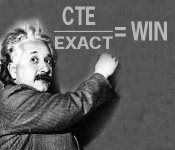Agreed.Lets clear something up here, manual cte is the framework for Pro1 and you know this!CTE stands for "center to edge." CTE aiming systems use a line from the center of the CB to the outer edge of the OB as a visual reference to help define an initial off-center cue alignment. Then the cue is pivoted to center ball to establish the final aiming line. Several popular versions of CTE are described here:
Beneath the descriptions is a thorough analysis of the limitations of the systems along with explanations of how they can be made to work over a wide range of shots.
Following the procedures exactly with a fixed bridge pivot will not create the necessary lines of aim for a wide range of shots. However, if you vary your "effective pivot length" (e.g., by "air pivoting" and/or by deforming your bridge during a fixed-bridge pivot), then the systems, with lots of practice, can be used effectively for all shots. Again, see the CTE resource page for illustrations and detailed explanations.
Are the systems exact, as described? IMO, hell no!!! (... except when one of the limited lines of aim happens to create the exact cut angle necessary for a particular shot.)
Can the systems be used to arrive at the exact line of aim required for every shot? Yes, but only if you can vary the initial bridge placement and/or effective pivot length the exact amounts required for each shot. This is not easy to do.
Regardless of the limitations of align-and-pivot aiming systems like CTE, they do offer some people significant benefits.
Pro-One is based on Stan's version of CTE (AKA "manual CTE"). Pro-One uses an "air pivot" instead of a bridge pivot, but the approach is the same.So stop using manual cte as if it were the finished product. When you know Pro1, that is when you have graduated!
I've explained this to you several times already. Stan's DVD does not present the shot categories directly. Instead, he provides a large number of examples that reveal the pattern indirectly. What I call "medium thin" is just part of the pattern as the cut angle gradually increases from straight-in to thin. Look at the pattern in the summary provided on my website. As the cut angle increases, the pattern in each column is consistent and clear. Stan did not present it exactly like this, but this is how I interpreted his system after watching and studying all of the examples several times.I tell you what, you show me your medium thin shot from your table on the dvd and give a time that shows this shot and i will never post again! if you fail to show me, all i ask is for you to stop trying to deceive people by pushing the manual cte results as the finished pro1 system.
Spidey and others have claimed my summary captures the gist of Stan's system fairly well. I know you don't agree, but we will just have to agree to disagree on this one.
Regards,
Dave
